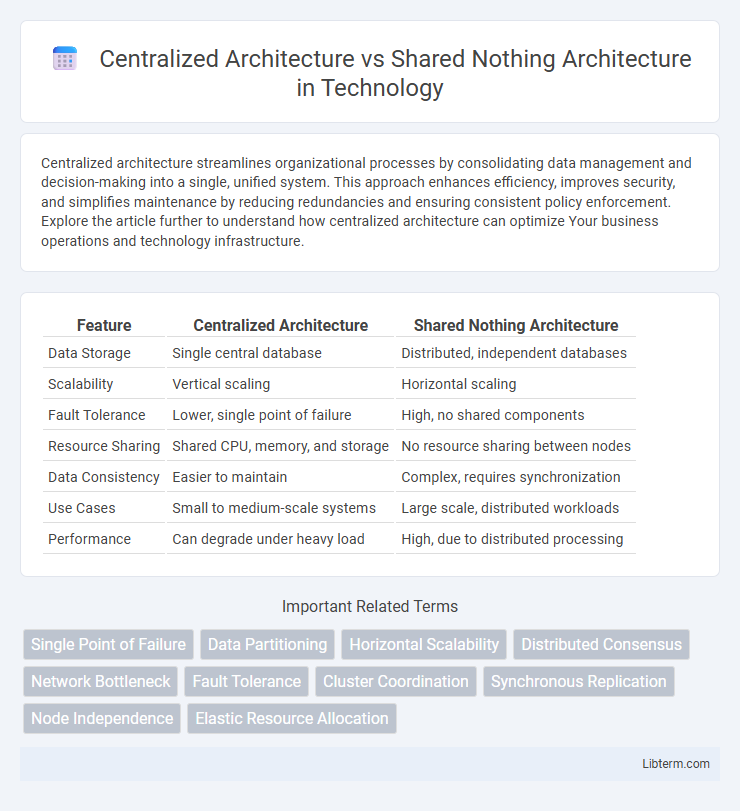Centralized architecture streamlines organizational processes by consolidating data management and decision-making into a single, unified system. This approach enhances efficiency, improves security, and simplifies maintenance by reducing redundancies and ensuring consistent policy enforcement. Explore the article further to understand how centralized architecture can optimize Your business operations and technology infrastructure.
Table of Comparison
| Feature | Centralized Architecture | Shared Nothing Architecture |
|---|---|---|
| Data Storage | Single central database | Distributed, independent databases |
| Scalability | Vertical scaling | Horizontal scaling |
| Fault Tolerance | Lower, single point of failure | High, no shared components |
| Resource Sharing | Shared CPU, memory, and storage | No resource sharing between nodes |
| Data Consistency | Easier to maintain | Complex, requires synchronization |
| Use Cases | Small to medium-scale systems | Large scale, distributed workloads |
| Performance | Can degrade under heavy load | High, due to distributed processing |
Introduction to System Architectures
Centralized architecture consolidates processing power and data storage within a single system or location, optimizing resource management but potentially creating bottlenecks and single points of failure. Shared nothing architecture distributes data and processing across multiple independent nodes, enhancing scalability and fault tolerance by minimizing resource contention and interdependencies. Both architectures serve as foundational models in system design, influencing performance, reliability, and scalability according to application requirements.
Defining Centralized Architecture
Centralized architecture is a system design where all processing and data storage occur on a single central server or mainframe, enabling tight control and simplified management. It centralizes resources, which eases maintenance but can create performance bottlenecks and a single point of failure. This architecture contrasts with distributed models by relying heavily on one core location for executing tasks and managing data.
Understanding Shared Nothing Architecture
Shared Nothing Architecture distributes data and computing resources across multiple independent nodes, each with its own memory and storage, eliminating resource contention and single points of failure. This design enhances scalability and fault tolerance by allowing nodes to operate and fail independently without impacting the entire system. Commonly used in large-scale distributed databases and web applications, shared nothing systems optimize performance by ensuring data locality and parallel processing.
Key Differences Between Centralized and Shared Nothing
Centralized architecture relies on a single, unified system handling all processing and storage, leading to potential bottlenecks and single points of failure, whereas shared nothing architecture distributes processing and storage across multiple independent nodes, enhancing scalability and fault tolerance. Centralized systems often face limitations in handling large-scale workloads due to resource contention, while shared nothing enables horizontal scaling by adding more nodes. Data management in centralized architecture is simplified with a single data repository, contrasting with the distributed data ownership and partitioning in shared nothing systems that require complex coordination.
Scalability Considerations
Centralized architecture faces scalability limitations due to resource contention and a single point of failure, restricting performance growth as workload increases. Shared Nothing architecture enhances scalability by distributing data and processing across independent nodes, eliminating contention and allowing horizontal scaling. This model supports fault tolerance and linear performance improvement, making it ideal for large-scale, high-traffic applications.
Fault Tolerance and Reliability
Centralized Architecture relies on a single point of control, making it vulnerable to system failures that can impact overall fault tolerance and reduce reliability. Shared Nothing Architecture distributes data and processing across independent nodes, enhancing fault tolerance by isolating failures and maintaining system reliability through redundancy. This design minimizes downtime and supports continuous operation even if individual nodes fail.
Performance Implications
Centralized architecture often faces performance bottlenecks due to limited resource scaling and single points of failure, leading to increased latency under high workloads. Shared nothing architecture enhances performance by distributing data and processing tasks across multiple nodes, minimizing contention and enabling horizontal scalability. This architecture reduces resource conflicts and improves fault tolerance, making it well-suited for large-scale, high-throughput applications.
Security Aspects
Centralized architecture centralizes data and control, creating a single point of failure and a potential target for cyberattacks, which requires robust access controls and encryption protocols to mitigate risks. Shared nothing architecture distributes data and processing across multiple nodes, reducing the attack surface and limiting the impact of breaches by isolating faults and minimizing data exposure. Security in shared nothing systems benefits from decentralized authentication and granular permission management, enhancing resilience against unauthorized access and data tampering.
Use Cases and Industry Applications
Centralized Architecture excels in environments requiring consistent data management and simplified system control, such as financial institutions and government agencies where centralized security and compliance are paramount. Shared Nothing Architecture suits large-scale web applications, e-commerce platforms, and real-time analytics requiring high scalability, fault tolerance, and distributed data processing across independent nodes. Industries like telecommunications, cloud services, and big data analytics leverage Shared Nothing to handle massive concurrent transactions and real-time data streams efficiently.
Choosing the Right Architecture for Your Needs
Choosing the right architecture between Centralized and Shared Nothing depends on your system's scalability, fault tolerance, and performance requirements. Centralized architecture offers easier management and consistency but may become a bottleneck under high load, while Shared Nothing architecture enables horizontal scaling and high availability by distributing data and workload across independent nodes. Analyzing workload patterns, data consistency needs, and infrastructure costs ensures optimal alignment with business objectives and technical demands.
Centralized Architecture Infographic

 libterm.com
libterm.com